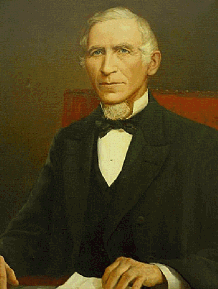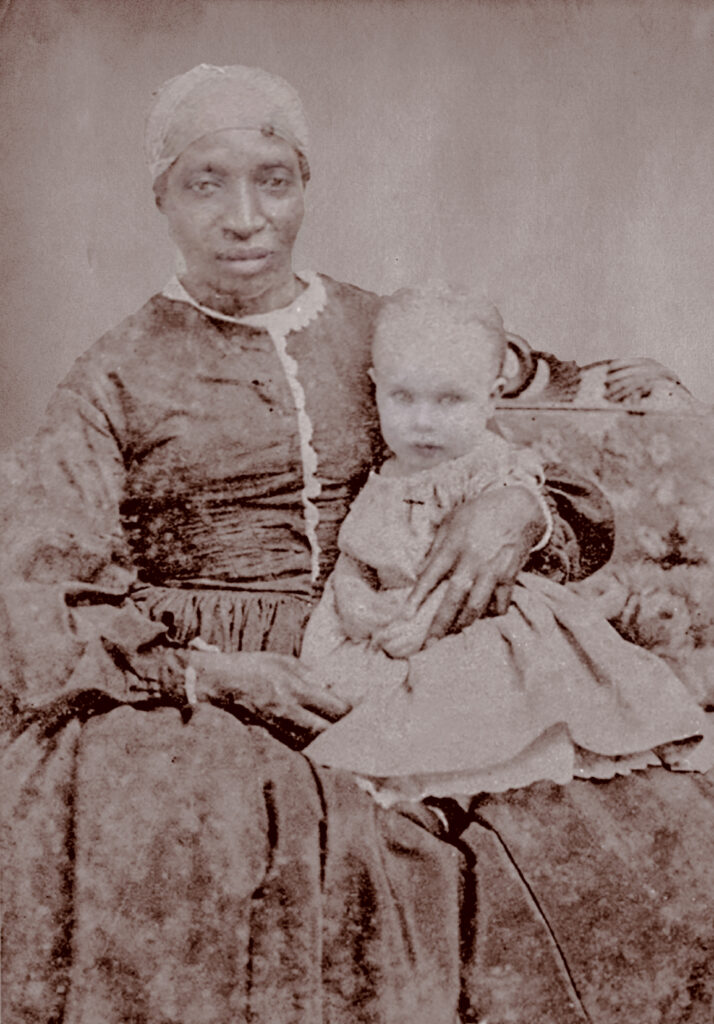The photo of the enslaved woman Jints and the toddler she cared for, Hannah Stockely (1858 – 1920), is of special significance to anyone interested in the history of the Broadkill Hundred. This is the only known photograph of any enslaved person in Delaware; the names of the subjects are known; and the apparent age of toddler Hannah Stockely reliably dates the photograph to about 1860. Above all, it is the fact that Jints and Hannah lived in the Broadkill Hundred, in the area surrounding Milton, that reminds us that Delaware in the pre-Civil War era was one of the fifteen states in which the enslavement of human beings was legal.
When this photograph was taken, the number of enslaved persons in Delaware had been in steep decline for decades. Only 1,797 enslaved in the state were counted in the 1860 Federal census out of a total of 21,627 Black residents. The majority of the enslaved, 1,341 in number, were found in Sussex County. Out of this last number, 142 were counted on the 1860 Federal Census Slave Schedule for the Broadkill Hundred.
The Federal Census Slave Schedules are useful for identifying enslavers, but of minimal value for identifying the enslaved; the latter were enumerated anonymously, with only age and gender recorded. In the case of Jints, the Slave Schedule was a bit more informative. According to the Delaware Public Archives, we know she was owned by James Anderson, the largest slaveholder in the Broadkill Hundred with 15 people in bondage. We also know from the 1860 Slave Schedule that there were only two adult females among his property, one aged 40 and the other 50. The others were in all likelihood field hands, and we know that at least one and probably both of the women were domestic servants. I am going to go out on a limb and guess that Jints was the younger of the two domestics. Anderson’s daughter, Ellen (1823 – 1915) was the wife of future Delaware governor Charles Stockely (1819 – 1901). The couple and their daughter Hannah resided in Anderson’s household, and Jints quite probably was the one to have raised Hannah in her early years.
The number of persons enslaved by Mr. Anderson is unusually high for the Broadkill Hundred and Sussex County in general. Most historians are in agreement that Delaware’s marginally productive soil and small family farms were not conducive to growing the kind of cash crops such as sugar cane and cotton that required a large labor force. For those farms that required extra hands, it was cheaper to hire free Blacks than to buy, house, clothe and feed slaves. It is worth noting the names of some of the owners on the 1860 Broadkill Hundred Slave Schedule, however:
- James Ponder, future governor of Delaware and one of the wealthier men in Milton: one 27 year old female and her 1 year old child
- David Hazzard, former governor of Delaware: one 29 year old female and her 9 year old child
- Sarah A. Paynter, whose son John Henry Paynter married Hanna Stockely: two middle-aged females and a 10 year old boy. Before his death in 1845, her husband Samuel Paynter owned 5 slaves.



In May of 2016, a Delaware state archivist ran across a list slaveholders and their property compiled in 1866; that list was a way of estimating how much revenue the state stood to lose as a a result of the slaveholders’ loss of their “taxable property.” The list also revealed James Anderson to be among the last slaveholders in the state, retaining ownership of 8 persons right up until the ratification of the 13th Amendment in December 1865, months after slaves in the former Confederacy had been freed. His son-in-law Charles Stockely also appeared on that list, retaining ownership of one slave in the Georgetown Hundred.

All traces of Jints after the 1860 photograph are lost to history. Her young charge Hannah led a quiet life in relative obscurity as the wife of Judge John Henry Paynter. Whether she ever saw the photograph or remembered anything of Jints, we may never know.Meanwhile, David Hazzard, James Ponder and Samuel Paynter, all native to the Broadkill Hundred, are commemorated on a plaque along Milton’s Governors Walk with two other governors who made their home in Milton, Dr. Joseph Maull and William Carey. The Maull and Carey never owned slaves.
It is hard to accept the commemoration of famous men who owned human beings, and in the case of James Ponder, who actively fought to restrict their enfranchisement in the Reconstruction era. The pantheon of the Confederacy has been under siege for years, with its most visible statuary in Richmond, VA already removed and its other symbols disappearing from state houses in the South. The Confederacy, its leadership, and its iconography are just the most visible targets, however. The institution of slavery was in place in the English colonies for hundreds of years before the Civil War, and was a thorny subject for the framers of the Constitution. Thomas Jefferson, James Madison, Benjamin Franklin, and Alexander Hamilton all owned other human beings, and so did George Washington. Many other lesser figures in the early days of the republic, in the Southern and border states, were enslavers.
We here in the Broadkill Hundred face the same issue bedeviling the country as a whole: how do we wish to remember profoundly flawed human beings who oppressed one group of people but served their state or their nation in many other, hugely important ways?
The debate around the issue at the national level continues and is likely to get more acrimonious. I am not sure there has ever been any discourse around the slaveholding gentry of Sussex County who became leaders of their state. I do offer one suggestion: every schoolchild (and their parents) in Delaware should become familiar with the photograph of Jints and Hannah, and the family and social relationships that allowed slavery to persist despite economic disincentives and strong opposition among Quakers and other abolitionists.
Sources
https://www.journals.uchicago.edu/doi/abs/10.2307/2717524?journalCode=jnh


My husband and I were just wondering how many slaves were on the Delmarva peninsula. And your article was so helpful in answering the question at least for Sussex County. I’m inclined to believe there were more enslaved in MD and VA. Thank you for your search into the history of this area.
Ms. Smith, thank you for your interest in the post. Figures for the enslaved populations in all three states are available, but you’re right in thinking that there were many more in MD and VA. The latter is much larger in area and had an enslaved population of 490,865 in 1860. In some VA counties, slaves outnumbered the white population several times over. That is not to say that all was well with agriculture in the Old Dominion; poor farming methods and the cultivation of tobacco had exhausted the soil and depressed land values on the eve of the Civil War. Maryland, with a smaller land area, had a population of 87,169 slaves in 1860. Slave schedules in the 1860 Federal Census would give more precise figures for the counties in the DelMarVa Peninsula.
Thank-you for your blogs about the history of Milton and the surrounding area
It has been so interesting to learn about the place I now call home.
Thank you for your interest Dale! There are so many transplants to this area in recent years, and my desire is to awaken a sense of time and place in all of them regarding Milton. Be sure to check out the Great Fire of 1909 exhibit at the Lydia B. Cannon Museum, 210 Union Street. The museum will reopen with regular hours starting Jan. 7, on Fridays and Saturdays from 11:00 AM to 4:00 PM, and possibly Thursdays as well; check their Facebook page for hours of operation. No event transformed downtown Milton in one fell swoop as the fire of Aug 13, 1909 did, and the downtown area that you see today is mainly the result of the fire.
[…] This content was originally published here. […]
Well spoke! My ties to Milton, Broadkill and Rehoboth are of long standing for I was born Shirley Anne Mears in Milton in 1933. My father’s family in Milton and Rehoboth were the loves of my childhood .Our Mears family has always remained close and my summer vacations with Grandmother Mears and cousins at Broadkill Beach are very precious memories. I look forward to your blogs eagerly and enjoy them so much. When I read about my Great-grandfather Mears and the barbershop where Dad and Mother began their marriage living in the apartment above the shop, I always chuckle for mother told how she sat at the window and watched Dad gradually become bald as he crossed the street on his many visits To Harvey and Charlotte Spicer’s shop (restaurant?). I admit I can’t remember what Harvey’s venture was then. My parents and the Spicers were life-long friends . Stories of Great-grandfathers tales and Harvey and Charlotte abound. —Thanks for listening and keep writing.
Shirley, thank you so much for your continuing interest in the blog; people like you with deep roots in Milton are a hugely important audience for what I write, for it is through you that I make new connections to the past. The Mears building on Federal Street was one of the first to be built after the fire of 1909 burnt much of downtown, so I have a keen interest in it. If you find yourself in Milton in the next six months, please come visit the Lydia B. Cannon Museum on Union Street; we’ve just opened our first new exhibit in two years, about the Great Fire of 1909.